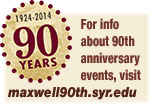The More Things Change
July 1, 2014
Related:
These short articles are published as supplements to Maxwell Perspective’s overview of 90 years of Maxwell School history, “The More Things Change.”

Hoover and the MPA
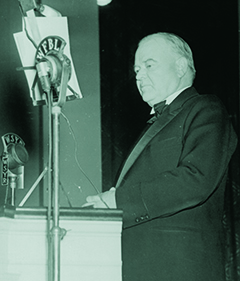
In 1937, former president Herbert Hoover, just a few years out of office, spoke at the dedication of Maxwell Hall (right). He talked about the importance of training young people to be active citizens while also lauding Maxwell’s pioneering MPA program.
Universities traditionally aim “to train minds and to strengthen character” and “to transmit the accumulated learning and culture of ages on to each rising generation,” said Hoover, as reported by the New York Times. But universities had expanded this mission into addressing “the day-to-day practical problems of life,” he added. “And now this institution especially has led in endeavor to lift public administration to a profession.”
One reason for the urgency of this job, Hoover noted, was the growth in government jobs. “We have increased the people who live on the public payroll from 1 percent of the population to over 10 percent, and they certainly need training.” That training entails more than “the addition of specialized scientific skill to general culture,” Hoover said. “It means the creation of a body of ethics and honesty in professional conduct, together with pride and distinction in a calling.”
Building Maxwell
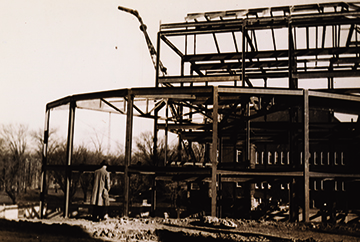
In October 1924, when Maxwell formally opened, the School’s home was the second floor of the recently completed Slocum Hall. The need for more space became quickly evident and plans were hatched for the School’s own building. Progress was slowed by the Great Depression, but the Georgian colonial brick building, with its Ionic columns, was dedicated in 1937, accommodating four departments, 32 faculty members, fewer than 100 graduate students, and classrooms adequate also for undergraduate courses.
Fast-forward 50 years, and Maxwell encompassed 15 departments/programs and 125 faculty members, serving more than 700 graduate students and 1,600 undergraduate majors. By 1989, components of Maxwell had scattered onto ten locations around campus, and professors were teaching more than 90 percent of their courses outside Maxwell Hall. Hence the campaign for Melvin A. Eggers Hall, dedicated in 1994. The six-story building, constructed at a cost of $20 million and connected to Maxwell Hall (which also got a $5 million makeover), emphasized public areas to bolster the sense of community, and also provided a home for two new research institutes—the Campbell Public Affairs Institute and Global Affairs Institute.
Today the Maxwell/Eggers complex is a busy hub of teaching, research, and collaboration. A few of the School’s facilities and programs have expanded to other locations — the archaeology lab and aging studies faculty in Lyman Hall, and the centers for environmental policy, and for technology and information policy in Crouse-Hinds. But with those few exceptions the Maxwell School now operates within the comfortable confines of Maxwell and Eggers Halls.
The Political Fray
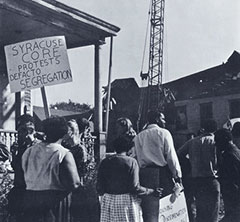
Considering that the Maxwell School was designed from the start to engage with civic issues and public policy, it’s no surprise that the School has been politically active throughout its history — and scrutinized and criticized for its perceived political leanings.
In the ’30s and ’40s, when Maxwell graduates were helping to lead a progressive movement in social-studies education and were also employed in large numbers by the burgeoning bureaucracy of the New Deal, the School was often under attack by conservatives — and tagged as “the little red schoolhouse” and “Marxwell.” Feeding into Maxwell’s liberal reputation, too, was the involvement of many faculty and students in the peace movement after World War I.
In the McCarthy era, right-wing attacks on the School intensified — despite the fact that some Maxwell professors at the time were producing fervently anticommunist works, such as The Communist Problem in America, edited by political science professor Edward E. Palmer. Even Maxwell Dean Paul Appleby was pulled into the fray, forced on several occasions to defend himself against charges of being a communist sympathizer.
During the political tumult of the 1960s, Maxwell students and faculty members were often at the center of antiwar and civil rights demonstrations on campus. One local issue that sparked impassioned protests was the state’s plan to raze Syracuse’s largely African-American 15th Ward to make a path for Interstate 81. In 1963, more than 150 SU students and faculty were arrested for chaining themselves to demolition equipment — including sociologist Byron Fox and political scientist Dale Tussing (still at Maxwell as an emeritus professor).
In the present era, though, Maxwell is as likely to be criticized for its conservatism as for its liberalism. In the 2000s, for example, faculty member Arthur Brooks was well-known for a series of Wall Street Journal op-eds debunking common liberal values, making pragmatic, data-based arguments for conservative policies and priorities. (Brooks is now president of the American Enterprise Institute, a conservative think tank.) It is likely that, today, both the American political landscape and the Maxwell School are too large and complex to ever occupy any one political pigeonhole.
Maxwell and Social Action (1949)
A publication marking the School’s 25th anniversary in 1949 noted that the combination of public administration graduate programs and undergraduate citizenship programs had created “a rather special character” in the School — one that those at Maxwell 65 years later may well recognize.
“While altogether normal and conventional programs may be had here as elsewhere, the School as a whole has come to be especially concerned with social action, with studying social organization in terms of action, in terms of public affairs and in terms of public responsibility,” stated the report. “Here democracy is seen not as an end but as means; here is continual and searching concern with the processes of democracy.”
This orientation of the School, the report added, influenced the selection of students — “to avoid the more self-centered and those characterized by parochialism and those who seem best able to work in relative isolation.” The most desirable students, by contrast, were those “who have already given evidence of skill in personal relationships, and who orient their scholarly interests toward social action and understanding the processes of social action.”
The Deans
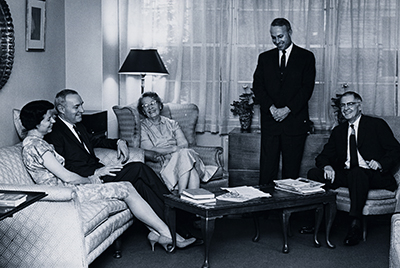
Nine deans have made their marks on the Maxwell School over 90 years.
William E. Mosher, 1924–45. Mosher was director of New York City’s Training School for Public Services when tapped to be Maxwell’s first dean. He developed the Responsible Citizenship course and textbook.
Paul H. Appleby, 1947–56. Appleby was a journalist who worked for the Agriculture Department and U.S. Bureau of the Budget. As dean, he created Maxwell’s first formal link with D.C., opening a research branch there.
Harlan Cleveland, 1956–61. Cleveland was the publisher of a political magazine (and former assistant director of the Marshall Plan) when named dean. He championed programs that introduced Americans to other nations and cultures. He left Maxwell to join the Kennedy administration.
Steven K. Bailey, 1961–69. A former small-city mayor and Princeton professor, Bailey joined the faculty in 1959. As dean, he expanded Asia and Africa programs and introduced an international MPA.
Alan K. Campbell, 1969–76. Campbell arrived in 1961 as creator and director of the Metropolitan Studies Program and later became dean. A year after leaving Maxwell, he was tapped to lead the U.S. Civil Service Commission.
Guthrie S. Birkhead, 1977–88. During 50 years at Maxwell, Birkhead served as director of Public Administration, chair of Political Science, and director of Metropolitan Studies. He taught long after his deanship.
John L. Palmer, 1988–2003. Before arriving at Maxwell (where he still teaches), Palmer was an economist in the U.S. Department of Health, Education, and Welfare. He oversaw fund raising for and construction of Eggers Hall.
Mitchel B. Wallerstein, 2003–10. A former deputy assistant secretary of defense, Wallerstein presided over a boom in international and security-related programs and the launch of the Moynihan Institute.
James B. Steinberg, 2011–. Steinberg was deputy secretary of state when appointed the ninth dean. Among highlights of his tenure thus far is a partnership with the Center for Strategic and International Studies, now home for Maxwell programs in Washington.
By Jeffrey Pepper Rodgers
These articles appeared in the summer 2014 print edition of Maxwell Perspective, except “The Political Fray,” which is supplemental website content; ©2014 Maxwell School of Syracuse University. To request a copy, email maxwellperspective@syr.edu.
Related News
School News

Oct 23, 2025
School News
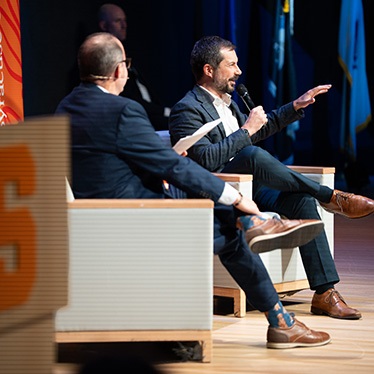
Oct 14, 2025
School News

Aug 25, 2025
